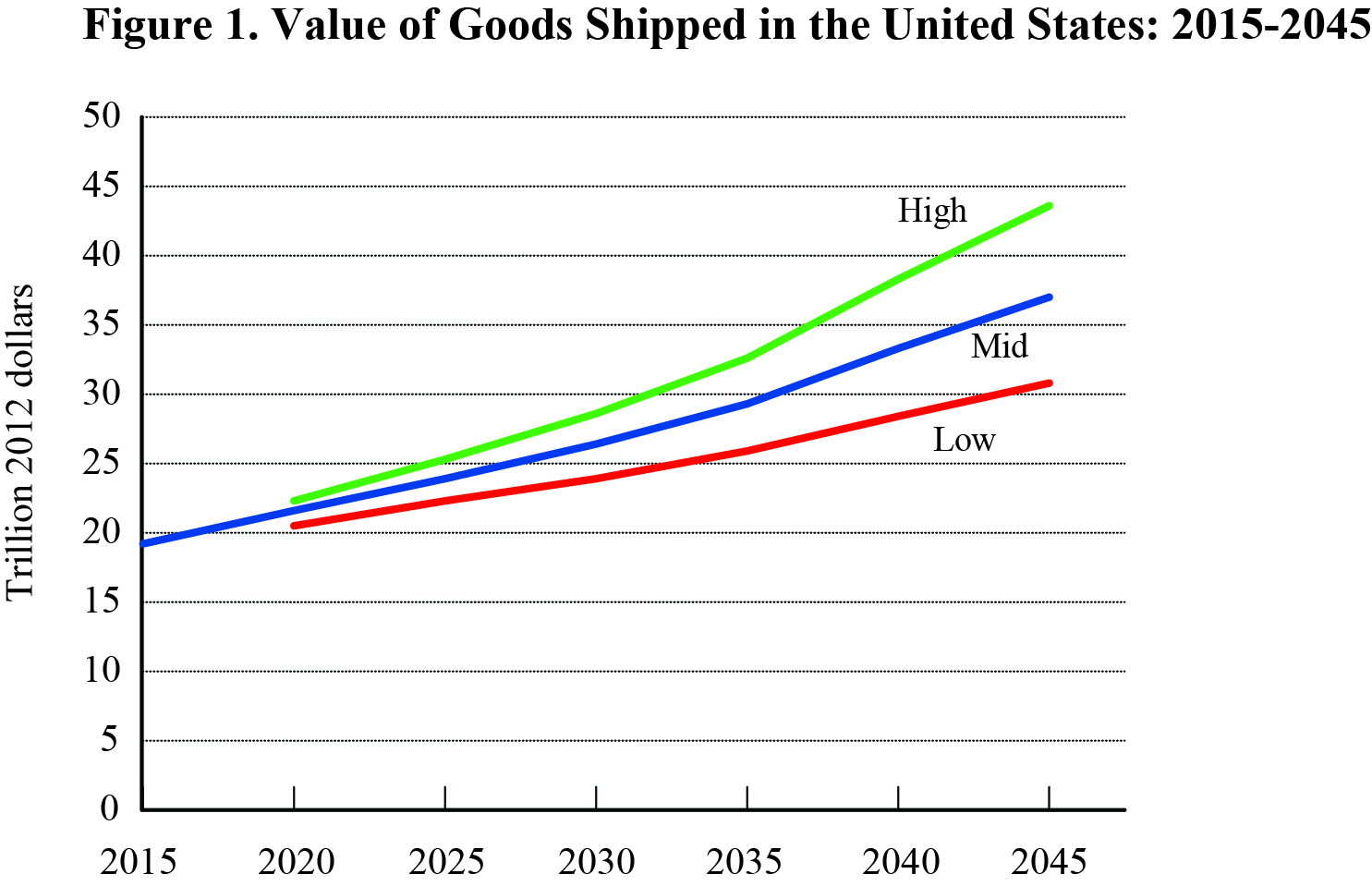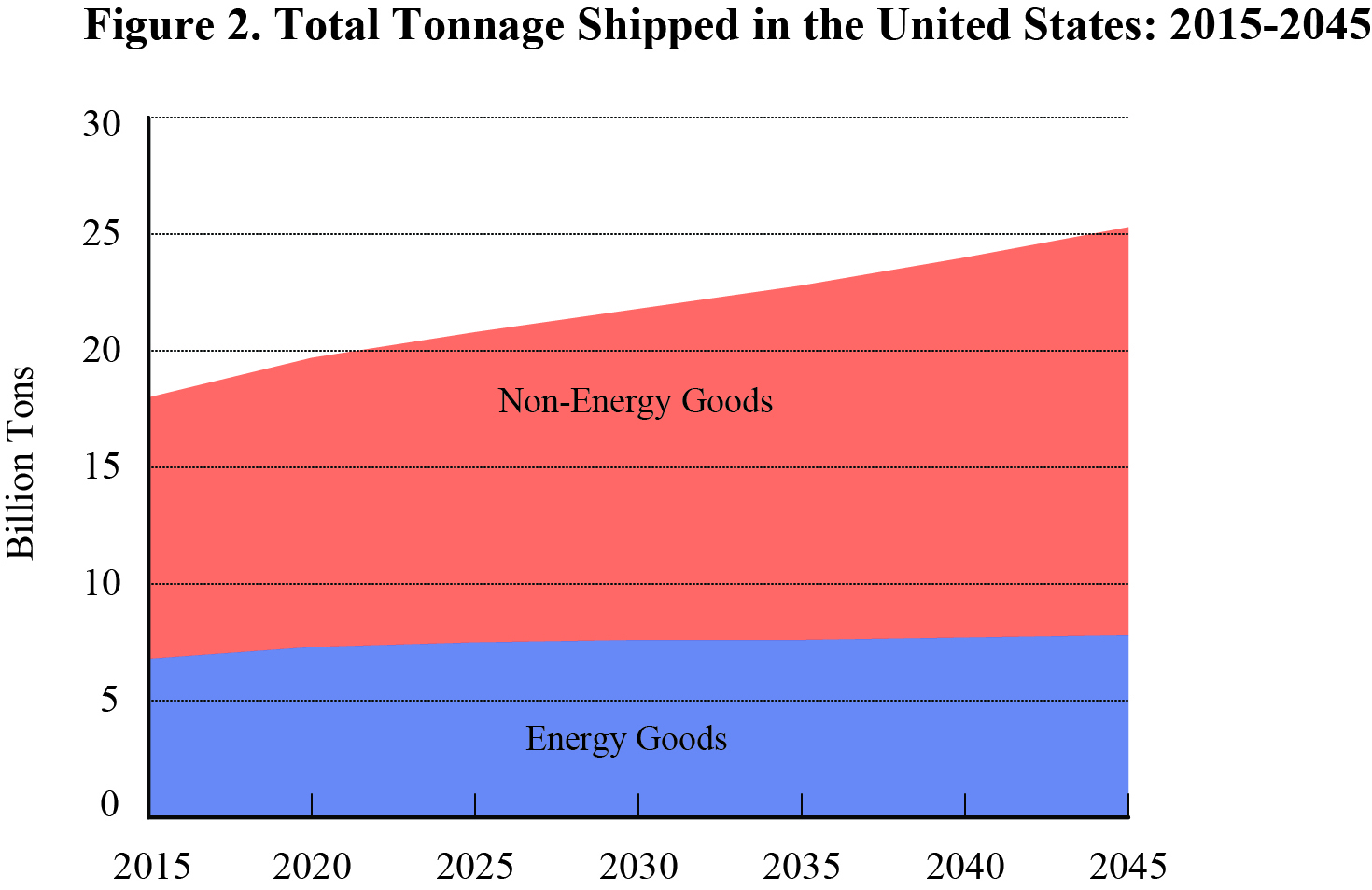DOT Releases 30-Year Freight Projections
U.S. Department of Transportation sent this bulletin at 03/03/2016 01:01 PM EST |
|
Having trouble viewing this email? View it as a Web page. |
BTS 13-16
Thursday, March 3, 2016
BTS Contact: Dave Smallen
Tel: 202-366-5568
FHWA Contact: Nancy Singer
Tel: 202-366-4650
DOT Releases 30-Year Freight Projections

Source: U.S. Department of Transportation, Bureau of Transportation Statistics and
Federal Highway Administration, Freight Analysis Framework, version 4.1, 2016.
New projections released today by the U.S. Department of Transportation’s Bureau of Transportation Statistics (BTS) and Federal Highway Administration (FHWA) show that freight tons moving on the nation’s transportation network will grow 40 percent in the next three decades while the value of the freight will almost double, increasing by 92 percent (Tables 1, 2).
By 2045, total freight on all modes – air, vessel, pipeline, rail, and trucks – is projected to reach 25 billion tons while the value is expected to grow to $37 trillion (Tables 1, 2).
The projections are from BTS’ and FHWA’s latest version of the Freight Analysis Framework (FAF), the most comprehensive publicly available dataset of freight movement.
The current estimates show that in 2015, nearly 18.1 billion tons of goods worth about $19.2 trillion were moved on our nation’s transportation network. On a daily basis, 49 million tons of goods valued at more than $53 billion are shipped throughout the country on all transportation modes (Tables 1, 2).
The projections show tonnage will increase, reaching 69 million tons per day by 2045, and the growth in value will outpace growth in tonnage, reaching $101 billion per day, or $37 trillion total, by 2045 (Tables 1, 2). This edition of FAF also includes high-growth and low-growth scenarios for 2020-2045 (Figure 1).
The mix of commodities has been changing in recent years and is projected to continue evolving. Energy commodities were 38 percent of total tonnage in 2015, and they are projected to decline to a 31 percent share by 2045. This is mostly due to increases for other goods. Tonnage for energy goods is projected to increase 14 percent by 2045, while non-energy goods are projected to increase by 56 percent (Figure 2).
Trucks are by far the single most-used mode to move freight, moving 64 percent of the tonnage in 2015 and 69 percent of the value. Tonnage for trucking is forecast to grow 44 percent by 2045, and value is forecast to grow 84 percent (Tables 1, 2).
The Freight Analysis Framework includes data on the amount and types of goods that move by land, sea and air between large metropolitan areas, states and regions. It is designed to provide information on national-level freight flows across the nation's transportation network. This information helps the public and private sectors at all levels better understand freight movement, and transportation planners use it to better target resources to improve operations or increase capacity. Today’s product adds current annual estimates and long-range forecasts to the origin and destination component of FAF. Additional elements are planned for future release.
More detail on the Freight Analysis Framework is available from BTS and from FHWA.
Table 1. Weight of Freight by Mode
(million tons)
|
Mode |
2015 |
2045 |
Change |
|
Truck |
11,513 |
16,529 |
+ 44% |
|
Pipeline |
3,303 |
4,554 |
+ 38% |
|
Rail |
1,694 |
2,094 |
+ 24% |
|
Water |
835 |
1,156 |
+ 38% |
|
Multiple Modes and Mail |
398 |
646 |
+ 62% |
|
No Domestic Mode |
273 |
297 |
+ 9% |
|
Air |
7 |
24 |
+ 234% |
|
Total |
18,056 |
25,331 |
+ 40% |
Source: U.S. Department of Transportation, Bureau of Transportation Statistics and
Federal Highway Administration, Freight Analysis Framework, version 4.1, 2016.
Note: Total includes total includes shipments by other and unknown modes that are not shown in the table.
* Includes crude petroleum imports that arrive by water at a waterside refinery.
Table 2. Value of Freight by Mode
(billion 2012 dollars)
|
Mode |
2015 |
2045 |
Change |
|
Truck |
13,267 |
24,406 |
+ 84% |
|
Multiple Modes and Mail |
2,129 |
4,336 |
+ 104% |
|
Pipeline |
1,445 |
1,797 |
+ 24% |
|
Air |
794 |
3,240 |
+ 308% |
|
Water |
694 |
1,517 |
+ 118% |
|
Rail |
657 |
1,198 |
+ 82% |
|
No Domestic Mode |
179 |
195 |
+ 9% |
|
Total |
19,249 |
37,014 |
+ 92% |
Surce: U.S. Department of Transportation, Bureau of Transportation Statistics and
Federal Highway Administration, Freight Analysis Framework, version 4.1, 2016.
Note: Total includes total includes shipments by other and unknown modes that
are not shown in the table.
* Includes crude petroleum imports that arrive by water at a waterside refinery.

Source: U.S. Department of Transportation, Bureau of Transportation Statistics and
Federal Highway Administration, Freight Analysis Framework, version 4.1, 2016.
Note: Tonnage amounts are based on data for the middle scenario. Energy Goods
include coal (SCTG 15), crude oil (16), light (17) and heavy (18) fuels, and other refined
petroleum products and natural gas (19).

